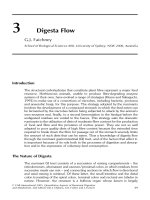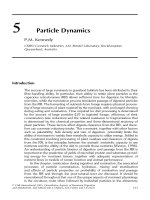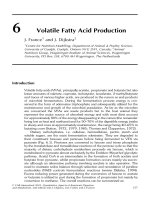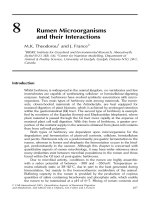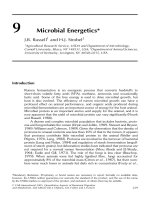Tài liệu Quantitative aspects of ruminant digestion and metabolism - Phần 10 pptx
Bạn đang xem bản rút gọn của tài liệu. Xem và tải ngay bản đầy đủ của tài liệu tại đây (256.67 KB, 28 trang )
13
Fat Metabolism and Turnover
D.W. Pethick,
1
G.S. Harper
2
and F.R. Dunshea
1,3
1
School of Veterinary and Biomedical Sciences, Murdoch University,
Murdoch, WA 6150, Australia;
2
CSIRO, Division of Livestock Industries,
St. Lucia, QLD 4067, Australia;
3
Department of Primary Industries,
Werribee, VIC 3030, Australia
Introduction
This chapter will emphasize the metabolism of non-esterified fatty acids (NEFA)
although some discussion will relate to triglyceride (TAG) and ketone bodies.
Plasma NEFA are a highly labile form of lipid that are transported between tissues
in the circulation bound to albumin. Although plasma NEFA are only a small
proportion (5%) of total plasma lipid they represent an important source of
oxidizable energy, particularly during periods of negative energy balance or
when there is an acute need for energy such as during exercise. This chapter will
deal with the composition and sources of plasma NEFA, the fate of NEFA during
different physiological states as well as the acute and chronic regulation of NEFA
metabolism. In addition, this chapter will cover methodology and principles of
NEFA metabolism and also describe adaptations to different physiological states.
Although these areas have been covered in several reviews (Lindsay, 1975;
Emery, 1979; Annison, 1984; Wiseman, 1984; Chilliard et al., 2000), this
chapter will emphasize the quantitative aspects of NEFA metabolism.
Composition and Sources of Plasma NEFA and TAG
The metabolically most active pool of long-chain fatty acids is transported and
metabolized as either NEFA (bound to albumin) or TAG. In the fed animal
NEFA represent less than 5% by weight of total plasma lipid (2 g/l) with the
remainder incorporated into various lipoprotein fractions (Kris-Etherton and
Etherton, 1982). TAG (<10% of plasma lipid) is present mainly as very low-
density lipoproteins (VLDL), with few chylomicrons on most diets. Sources of
plasma lipid include the gut, liver and adipose tissue.
The gut is limited in its quantitative contribution since the lipid content of
typical forage is less than 3%. A 45 kg sheep being fed to maintenance would
ß CAB International 2005. Quantitative Aspects of Ruminant Digestion
and Metabolism, 2nd edition (eds J. Dijkstra, J.M. Forbes and J. France)
345
consume about 700 g dry matter (DM) of good quality forage, including some
21 g of lipid (19 g of fatty acids) per day. Dietary lipid is absorbed as NEFA,
rapidly esterified to TAG and then packaged into chylomicrons and VLDL
within the intestinal mucosal cell (Noble, 1981). From here lipid enters the
lymph and finally the venous blood. Passage through the rumen results in
significant biohydrogenation, which is reflected in a relatively high proportion
of saturated fatty acids in the circulating TAG and NEFA of fed animals (Table
13.1). Mobilization of adipose tissue lipid (rich in oleic acid) during either
undernutrition or exercise results in a significant decrease in the saturation of
plasma NEFA and indeed the ratio of stearic to oleic (S:O) acids and the sum of
stearic and linoleic to oleic (SL:O) acids have been shown to be negatively
related to energy balance (Dunshea, 1987).
The dynamic nature of the profile of plasma NEFA is illustrated in Fig. 13.1
where the chronic and the acute-upon-chronic effects of undernutrition on
plasma NEFA and SL:O are shown. In this study, Dunshea (1987) fed goats
at either maintenance or 0.25 Â maintenance in 12 equally spaced meals per
day in an attempt to create a quasi-steady state. This was certainly achieved for
goats fed at maintenance where total NEFA concentrations and the ratio SL:O
were relatively constant across the 2-h interval between feeding. Sub-mainten-
ance feeding resulted in a chronic increase in plasma NEFA and a decrease in
SL:O. However, there were also post-prandial effects on both total NEFA and
SL:O consistent with dynamic changes in NEFA mobilization in response to the
2-hourly feeding bouts.
Lipolysis and Fat Mobilization
The major pathways within and adjacent to the adipocyte are shown in
Fig. 13.2 (see Vernon, 1981). Fat is stored as TAG. Glucose is the source
of glycerol while fatty acids can be either synthesized de novo, principally
from acetate, or be preformed. There is some evidence that intramuscular
Table 13.1. Composition of long-chain fatty acids (molar %) in blood of sheep.
(Data from Pethick et al., 1987; Pethick and Parry, unpublished.)
Fatty acid NEFA: fed at rest
a
NEFA: fasted NEFA: exercise
a
Myristic (C14:0) 1.5 0.8 0.8
Palmitic (C16:0) 26.7 20.8
b
20.8
b
Palmitoleic (C16:1) 4.0 4.2 3.8
Stearic (C18:0) 35.5 32.3 32.1
Oleic (C18:1) 23.9 37.5
b
37.6
b
Linoleic (C18:2) 5.2 2.2
b
3.4
b
Linolenic (C18:3) 2.9 ND ND
ND, not determined.
a
Fed a ration of ground and pelleted Medicago sativa.
b
Significantly different to fed sheep at rest.
346 D.W. Pethick et al.
0
200
400
600
5 25 45 65 85 105 125
Time relative to feed (min)
Plasma NEFA (µmol/l)
0.0
1.0
2.0
3.0
4.0
Plasma NEFA SL:O
Fig. 13.1. Relationships between plasma NEFA concentrations (open symbols), the ratio of
the molar proportions of stearic plus linoleic to oleic acids (SL:O) in NEFA (closed symbols)
and time relative to feeding in a dry goat that was chronically offered either 140 (&, &)or35
(^, ^ ) kJ ME/kg/day divided into 12 equal portions given at 120 min intervals (Dunshea, 1987).
Plasma
Endothel
Extracell
Fatty acid
Albumin
Fatty acid
Fatty acid
Fatty acid
Albumin
Glucose Glucose
Adipocyte
Glucose
Glucose-6P
Glyceraldehyde-3P
Dihydroxacetone-P
Pentose
phosphate
pathway
Acetyl-CoA
Malonyl-CoA
Glycerol Glycerol
Glycerol
Lipoprotein-TAG
7
6
4
6
5
Fatty acid
Triglyceride
1
2
Acetate Acetate
Acetate
3
Fig. 13.2. Triacylglycerol synthesis/degradation cycle in adipose tissue. TAG ¼ triacylglycerol.
1, Acetyl CoA carboxylase; 2, Fatty acid synthase; 3, Esterification; 4, Hormone sensitive lipase;
5, Lipoprotein lipase; 6, Fatty acid equilibration; 7, Membrane transport of fatty acids.
Fat Metabolism and Turnover 347
adipocytes have a preference for glucose and lactate over acetate but the
significance of this is still not fully resolved (Pethick et al., 2004). Preformed
fatty acids can arise from uptake of plasma NEFA or after hydrolysis of
circulating VLDL TAG by lipoprotein lipase (LPL). In addition, an intracellular
source of fatty acids can arise during lipolysis, a process regulated by hormone-
sensitive lipase (HSL). Fatty acids resulting from lipolysis can be released into
the circulation or else re-esterified into TAG. In contrast, the lack of glycerol
kinase within the adipocyte ensures that glycerol is quantitatively released into
the circulation. Therefore, glycerol and NEFA entry into the plasma pool
should reflect lipolysis and fat mobilization, respectively. This is provided that
the contribution from the adipocyte is much greater than that released into the
circulation as a result of LPL-catalysed hydrolysis of VLDL TAG which, as
discussed later, may not always be the case.
NEFA Entry Rate
Definition and methodology
Under conditions of constant circulating concentrations and physiological state
(steady state) the amount of NEFA entering and leaving the plasma will be
equal. This is defined as the NEFA entry rate, which is best determined by
isotope dilution. A potassium soap of radiolabelled fatty acids is dissolved in
plasma and infused intravenously at a constant rate. After about 1 h the specific
radioactivity of plasma NEFA in arterial blood will reach a plateau value and
entry rate can be calculated as:
Entry rate of total NEFA (mmol=h) ¼
Infusion rate radiolabelled NEFA (dpm=h)
Specific activity total NEFA (dpm=mmol)
The site of both infusion and sampling to determine NEFA kinetics has been
the source of some debate, but the above schedule has been validated (Jensen
et al., 1988).
Plasma NEFA consists of a number of fatty acids of which palmitic,
stearic and oleic acids represent some 85% (Table 13.1). Herein lies a
difficulty in quantifying NEFA metabolism because not all NEFA behave as
a homogeneous unit. Generally, one radioactive fatty acid is used as a tracer
for total NEFA, with the assumption that all NEFA behave similarly. Other
workers have improved the method by infusing mixtures of the three major
radiolabelled fatty acids (Bell and Thompson, 1979; Dunshea et al., 1988).
Typically, palmitic acid has a higher entry rate than the other fatty acids
when compared in a similar concentration (Lindsay, 1975). Stearic acid and
oleic acid more commonly show a similar relationship between entry rate
and concentration (Pethick et al., 1987). In this chapter (unless otherwise
directed) the tracer fatty acid has been assumed to be representative of all
NEFA. Finally, determination of NEFA concentration requires care. It is best
performed using either HPLC, GLC or enzymatic methods. Non-specific
348 D.W. Pethick et al.
methods employing titration of copper soaps are prone to overestimation
due to lack of specificity. Rapid, enzymatically based micro-assays now exist
for the determination of NEFA (Johnson and Peters, 1993) and unless
knowledge about specific fatty acids is required readers are recommended
to use these assays.
Plasma NEFA concentrations vs. NEFA entry rate
The published data for non-lactating small ruminants, in the fed and fasted
state, are summarized in Fig. 13.3. These studies have been grouped together
because in all cases the spectrum of tissues utilizing NEFA is similar. This
extends to pregnancy since the pregnant uterus uses very little NEFA (Pethick
et al., 1983). Secondly, the metabolic rate of tissues is not greatly altered.
Large changes in the metabolic rate alter the relationship between concentra-
tion and utilization or entry rate (Table 13.2; see also ‘Exercise’ below).
When all studies are viewed together (Fig. 13.3) a curvilinear relationship
is found, implying a plateau in the entry rate of NEFA. This plateau is not
due to peak stimulation of HSL since studies both in vitro (Vernon, 1981)
and in vivo (Table 13.6) suggest a much greater capacity. However, two
factors limit the extent of fat mobilization as the NEFA concentration
increases in plasma. First, in animals at rest, fat mobilization is associated
0.0
0.5
1.0
1.5
2.0
0.0 0.2 0.4 0.6 0.8 1.0
NEFA entry rate (mmol/h/kg)
Plasma NEFA (mmol/l)
0 50 100 150 200
Contribution to oxygen consumption (%)
Fig. 13.3. Relationship between the entry rate of NEFA, contribution of NEFA to oxidation and
circulating concentration in non-lactating animals. Key: O, sheep fed; &, sheep pregnant fed; Â,
goats fed; þ, goats underfed; ~ sheep starved 1 day; ~, sheep starved 3–4 days; &, sheep
pregnant starved 3–4 days. If x is the NEFA entry rate (mmol/h/kg) and y the NEFA in plasma (mM)
then y ¼ 0:05 Â 10
2:14x
, r
2
¼ 0:77(P < 0:001). In calculating the regression each study was
weighted for the number of animals. Contribution to oxygen consumption is calculated assuming
complete oxidation of NEFA and an oxygen consumption of 12.5 mmol/h/kg for all metabolic
states. No discrimination on the basis of tracer NEFA was made. Sources: Bergman et al. (1971);
Pethick et al. (1983, 1987); Dunshea et al. (1988); Pethick and Harman (unpublished); Hall and
Dunshea (unpublished); plus those cited by Vernon (1981).
Fat Metabolism and Turnover 349
with increased rates of ketogenesis (Table 13.5) and subsequent elevation of
D
-3-hydroxybutyrate. This ketone body tends to reduce NEFA concentration
probably by increasing the rate of insulin secretion (Heitmann et al., 1987).
Secondly, as NEFA concentration increases the plasma albumin approaches
saturation and the resultant stimulation of intracellular re-esterification re-
duces fat mobilization despite no change in lipolysis (Madsen et al., 1986).
These mechanisms regulate fat mobilization and are essential to prevent
toxic levels of NEFA in plasma (about 2 mM; Newsholme and Leech,
1983). Saturation of tissue uptake could also inhibit further elevation of
entry rate. In the liver, NEFA uptake is non-saturable within the physiological
range (Bell, 1981), but for skeletal muscle there is evidence for limited
uptake as the concentration of NEFA increases with fasting. The fractional
extraction of NEFA in fed sheep was over twice that found for fasted
counterparts (Table 13.2) despite similar blood flow in the hind limb muscle.
Muscle can form acetate or esterify NEFA, but it would appear that these
pathways can be saturated within the physiological range of substrate supply.
The oxidative pathway for NEFA can only increase to the limit set by oxygen
consumption and this is probably the major limiting aspect of NEFA utiliza-
tion at rest (Table 13.2).
The relationship between entry rate of NEFA and concentration in plasma
for lactating animals is shown in Fig. 13.4. The relationship is different for non-
lactating animals. First, the concentration of NEFA is generally lower than
observed in non-lactating animals, even though the range of NEFA entry rate
is similar or in the case of the fasted goat considerably higher. Secondly, there
is no tendency for the entry rate of NEFA to reach a maximum with a linear
relationship being adequate to explain the data. This is likely due to the
mammary gland acting as a non-saturable sink for long-chain fatty acids (see
also ‘lactation’ below).
Table 13.2. Metabolism of NEFA by the hind limb muscle of sheep. (Data from Pethick et al.,
1983 (flux rates across muscle halved due to overestimate of blood flow), 1987; Harman,
1991.)
Metabolic state
Plasma
NEFA (mM)
Gross utilization
by muscle
(mmol/h/kg)
Gross extraction
across muscle
(%)
O
2
uptake
by muscle
(mmol/h/kg)
Dry fed 0.1 + 0.01 0.1 + 0.02 19 + 411+1
Dry 3-day fasted 1.1 + 0.1 0.2 + 0.04 7 + 110+ 1
Pregnant 3-day fasted
a
1.6 + 0.2 0.5 + 0.1 8 + 115+ 3
Exercise 30% VO
2
max
b
1.1 + 0.1 1.0 + 0.2 9 + 247+ 3
Exercise 60% VO
2
max
b
1.6 + 0.2 2.3 + 0.2 7 + 280+ 12
a
Last month of pregnancy.
b
Exercise at 30% and 60% VO
2
max was at 4.5 km/h on 08 or 98 incline respectively, see
Harman (1991).
350 D.W. Pethick et al.
Utilization of NEFA
Tissue uptake
All tissues that utilize long-chain fatty acids also show simultaneous
release. Consequently the terms net and gross utilization have been used to
describe NEFA uptake by tissues. Net utilization is derived from the extraction
of NEFA measured as an amount while gross utilization is calculated from
the extraction of infused radiolabelled NEFA. For liver the difference between
the two values is not large; however, for the gut and muscle it is not uncommon
to find a net release of NEFA, while the mammary gland shows no net
exchange in fed animals. Reasons for tissue release of NEFA include
lipolysis due to LPL (mammary gland and muscle) and lipolysis from adipose
tissue within the tissue bed of interest (muscle and the gut). To discriminate
between the sources the method of Zierler and Rabinowitz (1964) could be
utilized, where a local infusion of insulin is given to inhibit HSL (Capaldo et al.,
1994).
There is no evidence that individual NEFA are utilized at different rates
by muscle, but there is conflicting evidence as to the rate of the stearic acid
utilization by liver. Bell (1981) reviewed the data and suggested minimal
hepatic utilization of stearic acid; in contrast there is substantial incorporation
of radiolabelled stearic acid into ketones, suggesting no impairment to uptake
(Pethick et al., 1983). In resting fed (and probably fasted) sheep about half of
the NEFA entry rate is accounted for by the gut, liver and muscle (Table 13.3).
Alternative sites might include the heart, kidneys and spleen. Assuming the
0.0
0.2
0.4
0.6
0.8
0.0 0.5 1.0 1.5 2.0 2.5 3.0 3.5
NEFA entry rate (mmol/h/kg)
Plasma NEFA (mmol/l)
Fig. 13.4. Relationship between the entry rate of NEFA and circulating concentration in
lactating animals. Key: O, cow fed; ~, goat fed, &, sheep fed, þ, goat fasted. If x is the NEFA
entry rate (mmol/h/kg) and y the NEFA in plasma (mM) of fed animals, then y ¼ 0:27xþ
0:17, r
2
¼ 0:36 (P < 0:001). If the value for the fasted goat is included, the slope is significantly
reduced to 0.15, r
2
¼ 0:45 (P < 0:001). In calculating the regression each study was weighted for
the number of animals. Sources: Annison et al. (1967a, 1968); Yamadagni and Schultz (1969);
Bickerstaffe et al. (1972, 1974); Konig et al. (1979, 1984); King (1983); Emmanuel and Kennelly
(1984); McDowell et al. (1987, 1988); Bauman et al. (1988); Sandles et al. (1988); Dunshea et al.
(1989, 1990); Pullen et al. (1989); Sechen et al. (1989).
Fat Metabolism and Turnover 351
gross extraction of NEFA by the heart is 55% as in man (Wisneski et al., 1987),
the heart could utilize 19% of the NEFA entry rate. Finally, adipose tissue,
which receives 16% of the cardiac output at rest (Bell and Hales, 1985), could
also utilize significant NEFA. During exercise the muscle becomes a relatively
more important sink for NEFA.
Oxidation of NEFA
Whole body
Two methods are commonly employed to measure the oxidation rate of NEFA.
Either the entry rate of NEFA and CO
2
are determined along with the contri-
bution of NEFA to the blood bicarbonate pool at equilibrium, or alternatively an
open circuit calorimeter is utilized and the amount of radioactivity infused is
compared to that excreted as respiratory
14
CO
2
either at equilibrium or during
a 12 to 24-h period. For accurate results, long infusion times are preferred
since there is a delay (5 h) in the accumulation of
14
CinCO
2
(Annison et al.,
1967a). During ketosis this time extends to 15 h due to catabolism of NEFA via
ketones (Pethick et al., 1983). Another factor of concern is CO
2
fixation,
which amounts to 17% and 7% of CO
2
entry rate in fed and fasted sheep,
respectively (Annison et al., 1967a). The common NEFA in plasma are oxi-
dized at similar rates. However, due to ruminal biohydrogenation of fatty acids
the absorption of linoleate is low and hence there is limited oxidation of this
essential fatty acid (Lindsay and Leat, 1977). Estimates of prompt NEFA
oxidation are shown in Table 13.4. Inter-laboratory comparisons are difficult
but, whether fed or fasted, NEFA oxidation is relatively low and generally only
about half that of other fatty acids, such as acetate or ketones. Oxidation
increases during late gestation but there still remain substantial amounts of
NEFA, which enter non-oxidative pathways.
Table 13.3. Gross utilization of NEFA by different tissues in sheep. (Data from Bergman et al.,
1971; Pethick et al., 1983, 1987; Harman, 1991.)
Utilization as % of entry rate
Tissue Dry, fed
a
at rest Exercise
b
30–60% VO
2
max Fasted pregnant
c
Gut 8 5 ND
Liver 26 11–16 ND
Muscle
d
20 19–26 20
Total 54 35–47
ND, not determined.
a
Entry rate 0.1 mmol/h/kg.
b
Entry rate 1.6–3 mmol/h/kg.
c
Entry rate 0.6 mmol/h/kg, last month of pregnancy.
d
Muscle value extrapolated from measurements of hind limb muscle assuming that muscle weight is 24% of
fleece body weight (Butterfield et al., 1983).
352 D.W. Pethick et al.
Tissue oxidation
Measurement of tissue oxidation compares the rate of
14
C-NEFA uptake with
14
CO
2
release. Both long infusion and/or collection times are required for
reliable results. This is due to very slow equilibration of CO
2
, especially in
resting muscle (Pethick et al., 1983).
Direct oxidation of NEFA by resting muscle is low (Table 13.4) with values
reflecting that found in the whole animal. However, if fixation of CO
2
is
allowed for (possibly as high as 20%; Pell et al., 1986) then 50–60% of the
NEFA is probably oxidized in sheep. Even lower rates of oxidation were found
for the steer hind limb. These lower rates are perhaps surprising but they are
not related to poor methodology since short-chain fatty acids are extensively
oxidized in similar experiments (Pethick et al., 1981). Intramuscular fat might
act as a significant site of esterification; alternatively NEFA could pass through
an intramuscular pool of TAG before being directly oxidized (Dagenais et al.,
1976). A similar mechanism is implicated for adipose tissue (Ookhtens et al.,
1987). This may represent an adaptation to maintain intracellular NEFA
concentration below toxic levels. During exercise NEFA are directed more
Table 13.4. Oxidation of NEFA in ruminants.
a
Experimental
method
Metabolic
state/species
% NEFA promptly
oxidized References
Whole-body Fed animals
oxidation Dry sheep 47
a
Leat and Ford (1966)
Pregnant sheep 55, 70
a
Pethick et al. (1983);
Wilson (1984)
Growing heifers 32
a
Eisemann et al. (1986)
Lactating cows 15, 21 Bauman et al. (1988);
Pullen et al. (1989)
Fasted animals
Dry sheep (1 day) 37 Annison et al. (1967a)
Dry sheep (3 days) 45, 35
a
Lindsay and Leat (1977);
Leat and Ford (1966)
Pregnant sheep (3 days) 63, 46
a
Pethick et al. (1983);
Wilson (1984)
Oxidation by Sheep
hind-limb muscle Fed 40 Pethick et al. (1987)
Exercise, 30% VO
2
max 87 Pethick et al. (1987)
Fasted pregnant (3 days) 52 Pethick (1980)
Steer
Fed 3 Bell and Thompson (1979)
Fasted (1 day) 14 Bell and Thompson (1979)
a
Values corrected for CO
2
fixation using data from Annison et al. (1967a) of 1.2 and 1.07 for fed and fasted
animals, respectively. Experiments where
14
C-linoleic acid was used as a tracer have not been included.
Pregnant animals in last month of pregnancy.
Fat Metabolism and Turnover 353
readily to oxidation (Table 13.4) either directly or due to a higher rate of
esterification and lipolysis in muscle.
NEFA Metabolism in Different Physiological States
Fed animals at rest
Magnitude
Estimates of NEFA entry rate in maintenance-fed small ruminants range from
0.08 to 0.32 mmol/h/kg (21–121 g/day, see Fig. 13.3). Much of the vari-
ation in these measurements relates to the pattern of feeding, with the lower
values being observed in animals fed semi-continuously. Plasma NEFA levels
and entry rates are highest before and lowest after feeding (Dunshea et al.,
1988). A further source of variation occurs because plasma NEFA are highly
labile (t
1=2
< 2 min) and also very stress-sensitive (Holmes and Lambourne,
1970; Boisclair et al., 1997). In this context, Boisclair et al. (1997) found
that excitement around feeding or other minor animal handling procedures
were sufficient to elevate plasma NEFA, particularly in young cattle treated with
bovine somatotropin (bST). Therefore, it is imperative for animals to be accus-
tomed to handling before commencing studies. This has not always been the
case. The value of about 35 g/day appears to be a good estimate of the NEFA
entry rate in a 45 kg ruminant fed to maintenance, although lower values have
been measured (Pethick et al., 1987).
Sources of plasma NEFA and TAG
Estimates of lipid absorption in sheep fed roughage-based diets are in the order
of 12 to 16 g/day of TAG (Harrison and Leat, 1972; Pullen et al., 1988).
NEFA content of intestinal lymph is low such that only some 0.5 g/day enter
the circulating pool directly. However, the absorbed TAG also makes a
contribution towards the NEFA entry rate through the action of LPL and to a
small extent hepatic lipase. The work of Bergman et al. (1971) demonstrated
release of NEFA into the circulation as chylomicron TAG was hydrolysed by
liver, gut and hindquarters. The extent to which fatty acids liberated by LPL
pass through the circulating NEFA pool before intracellular metabolism is
questionable (Fig. 13.2); however, in Fig. 13.5 it is assumed that complete
equilibration occurs. A further source of TAG and NEFA is VLDL TAG formed
in the liver. While little de novo lipogenesis occurs in the liver of ruminants
(Bell, 1981), there is extraction of NEFA from the circulation with
subsequent release of about 4–5 g/day (double this in pregnant animals) of
VLDL TAG (Pullen et al., 1988; Freetly and Ferrell, 2000). Overall TAG
derived from the diet and liver might account for 50% of the NEFA entry rate
(Fig. 13.5).
The remaining component of NEFA entry rate probably arises from lipo-
lysis within adipose tissue. Again, some released fatty acids would emanate
from the action of LPL on circulating TAG but this contribution remains
unknown. The alternative source is due to the action of HSL. Further experi-
354 D.W. Pethick et al.
ments are required perhaps utilizing the fat-tailed sheep or an inguinal fat pad
as a model.
The relative contribution of adipose and non-adipose sources towards
plasma NEFA in the sheep can be derived from the work of Petterson et al.
(1994). In that study, insulin (a potent inhibitor of adipose tissue lipolysis) was
infused while maintaining euglycaemia. Maximally inhibited NEFA concentra-
tions are assumed to be the result of insulin-independent, LPL-catalysed hy-
drolysis of circulating TAGs. In the study of Petterson et al. (1994) insulin
infusion decreased plasma NEFA concentration from 0.15 to 0.07 mM in
sheep fed to maintenance. Given that at low concentrations of NEFA the
relationship between plasma NEFA concentration and entry rate is essentially
linear (Fig. 13.3), then lipolysis (via HSL) would account for about 50% of the
NEFA entry rate. Hyperinsulinaemia caused similar plasma NEFA concentra-
tions to the basal values observed by Pethick et al. (1987) where entry rate of
NEFA was 21 g/day. This value can be largely accounted for by the estimates
of NEFA derived via TAG metabolism from the diet (13 g/day) and hepatic
production (5 g/day). Therefore, it appears that in resting undisturbed sheep,
minimal NEFA are released into the circulation as a result of adipose tissue
Gut Plasma TAG
Acetate
13
LPL
0.5 18
Liver
5
Plasma
NEFA
10
Plasma
HSL
9
14
CO
2
14.5
5.5
Fig. 13.5. Source and fate of NEFA (g/day) in a dry sheep fed to maintenance. This figure
represents a working hypothesis to account for NEFA in a roughage-fed, 45 kg, dry sheep. Rates
and assumptions are discussed in the text. All values represent flux of NEFA whether in the form of
TAG-fatty acids or NEFA. The flux of NEFA into adipose tissue represents the sum of TAG
synthesis in all tissues. The estimated rate of lipogenesis from acetate is calculated from van der
Walt (1984). LPL ¼ lipoprotein lipase; HSL ¼ hormone-sensitive lipase; TAG ¼ triacylglycerol.
Fat Metabolism and Turnover 355

